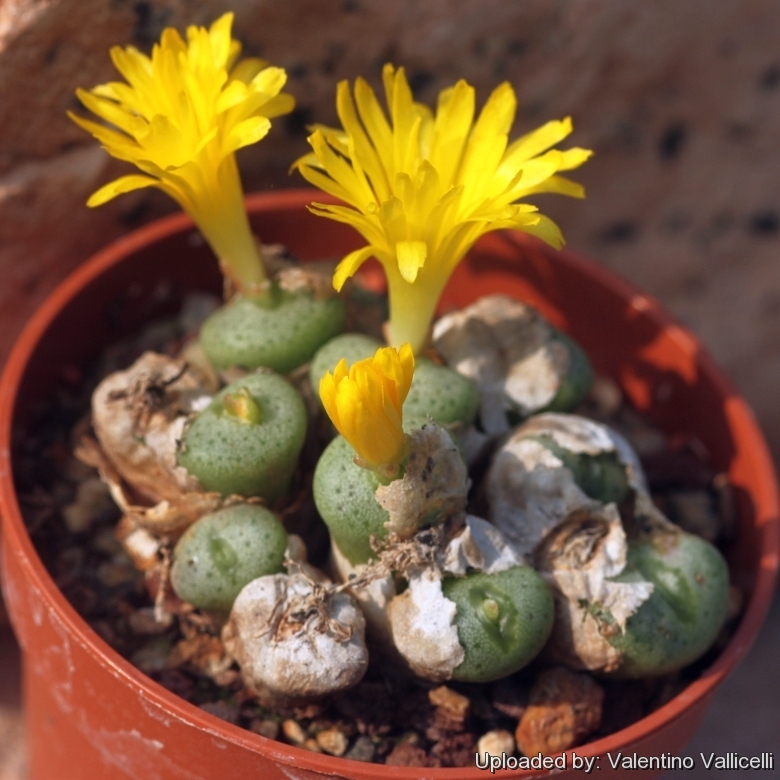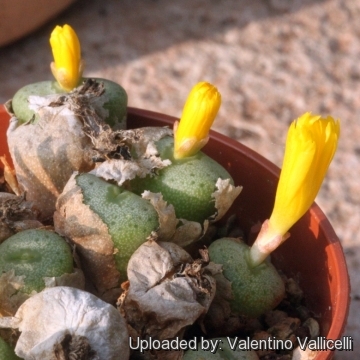
Conophytum flavum subs. novicium Photo by: Valentino Vallicelli
Origin and Habitat: Little Namaqualand, Northern Cape, South Africa.
Habitat: It grows on quartz or granite outcrops often very closely to populations of Conophytum flavumSN|14745]]SN|14745]] (subsp. flavum) but the two are not sympatric and apparently no hybrids between these are found.
Synonyms:
See all synonyms of Conophytum flavum
Description: Conophytum flavum subs. novicium is a small caespitose ground-cover species forming tight or loose mats or cushions. It can be confused with Conophytum minutumSN|17466]]SN|17466]] var. pearsonii, but flowers and sheaths differentiates them. Known to hybridise in habitat with Conophytum wettesteinii.
Stem: Stemless.
Bodies (paired leaves): Up to 8-12(-20) mm tall, 6-8(-9) mm in diameter, constricted below the top, circular, flattish convex on the top, with a very slight depressed fissure, light greyish-green to deep green, glabrous to finely papillate, spotted with darker green dots, often shiny.
Flowers: Small, diurnal opening in the morning, 15-20 mm in diameter, tube projecting for up to 15 mm, petals yellow to golden yellow.
Fruits: 4-5 chambered.
Chromosome number 2n: 36.
Subspecies, varieties, forms and cultivars of plants belonging to the Conophytum flavum group
Bibliography: Major references and further lectures
1) Steven A. Hammer “The genus Conophytum: a conograph” Succulent Plant Publications, 1993
2) Steven A. Hammer “Dumpling and his wife: new views of the genus Conophytum” EAE Creative Colour Ltd., 2002
3) Werner Rauh “The Wonderful World of Succulents: Cultivation and Description of Selected Succulent Plants Other Than Cacti” Smithsonian Institution Press, 1984
4) Gibbs Russell, G. E., W. G. Welman, E. Reitief, K. L. Immelman, G. Germishuizen, B. J. Pienaar, M. v. Wyk & A. Nicholas. 1987. “List of species of southern African plants.” in: Mem. Bot. Surv. S. Africa 2(1–2): 1–152(pt. 1), 1–270(pt. 2).
5) James Cullen, Sabina G. Knees, H. Suzanne Cubey “The European Garden Flora Flowering Plants: A Manual for the Identification of Plants Cultivated in Europe, Both Out-of-Doors” Cambridge University Press, 11/Aug./2011
6) Ernst Van Jaarsveld, Ben-Erik Van Wyk, Gideon Smith “Succulents of South Africa: A Guide to the Regional Diversity” Tafelberg Publishers, Limited, 01/lug/2000
7) Heidrun E.K. Hartmann “Illustrated Handbook of Succulent Plants: Aizoaceae A-E” Springer, 2002
 Conophytum flavum subs. novicium Photo by: Valentino Vallicelli
Conophytum flavum subs. novicium Photo by: Valentino Vallicelli Conophytum flavum subs. novicium Photo by: K.k. Agrawal
Conophytum flavum subs. novicium Photo by: K.k. Agrawal Conophytum flavum subs. novicium Photo by: Valentino Vallicelli
Conophytum flavum subs. novicium Photo by: Valentino Vallicelli Conophytum flavum subs. novicium Photo by: Valentino Vallicelli
Conophytum flavum subs. novicium Photo by: Valentino VallicelliCultivation and Propagation: It is relatively easy to grow. These plants grow on winter rain and head for summer dormancy. More or less dormant in summer.
Soil: Use well-drained soil mix.
Water: The plant requires little water; otherwise its epidermis breaks (resulting in unsightly scars). Water throughout the year although minimally in summer, (only when the plant starts shrivelling), but it will generally grow even in summer if given water. Water regularly in winter after the previous year's leaves have dried up. Requires good drainage.
Exposure: Plants prefer morning sun and some protection against afternoon hot sun in mid-summer; it needs full sun or light shade in the other seasons. Keep dormant in summer and keep protected during this period.
Hardiness: Hardy to -2°C. Ensure a very good ventilation.
Maintenance: Avoid to repot frequently. This plant may stay in the same pot for many years. Plants grown in larger containers have frequently relatively poor flowers. It might improve when the plants are given their own, small individual pots. With age the plants can grow raggedly leggy and it is best to renew them from cuttings.
Propagation: It can be reproduced both by cuttings and seeds. Take the cutting from a grown-up mother plant. Each cutting must contain one or more heads, along with a fraction of root.














